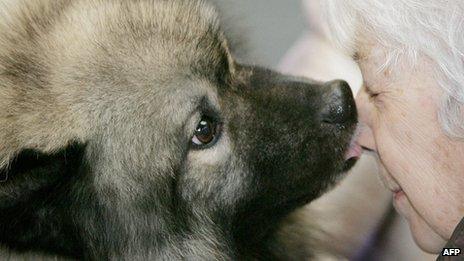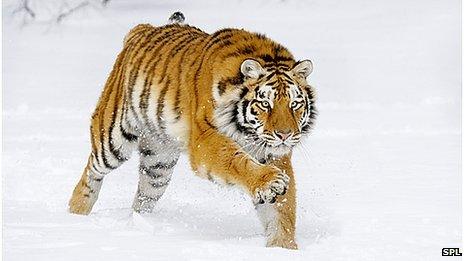Canine virus threatens Siberian tiger
- Published
.jpg)
Canine distemper virus (CDV) is the latest of many threats to the Siberian tiger
The Siberian tiger: majestic, enigmatic - the classic big cat precariously balanced on the edge of extinction.
Threatened by deforestation and poaching to supply the black market trade in tiger body parts, it is one of the most endangered cats on the planet.
But over the past decade or so, a new threat has emerged - a silent, insidious one - canine distemper virus.
Worldwide there are an estimated 400-500 Siberian or Amur tigers.
Exact numbers are hard to determine because this is a reclusive animal that is rarely observed.
Yet, at the turn of the century, some of these otherwise withdrawn animals were seen wandering onto roads and into villages in the Russian Far East. They were fearless and docile, confused and dazed; the antithesis of their usual ferocious and wary demeanour.
Over the next few years evidence mounted that this, the largest living felid, was suffering from an infectious agent and the indications - the nature of the illness, historical understanding of wild cat infections and the diagnosis, in a single wild tiger, of a virus belonging to the morbillivirus genus - provided a likely culprit.
A study published in the journal mBio, external, confirmed these suspicions. Genetic analysis of several dead tiger samples showed that canine distemper virus was the cause.
Canine distemper virus (CDV), a relative of the human measles virus, was first described in dogs and infection causes fatal pneumonia and encephalitis (inflammation of the brain).
Lack of respect
But this virus is incredibly promiscuous and can infect jump into a variety of different animals - usually with catastrophic effects.
Two suspected CDV outbreaks, the first in 1988 and a second in 2000, killed thousands of Baikal then Caspian seals.

A successful campaign with vaccine-laced bait led to Germany being declared rabies-free
The virus has also ripped through Africa, with fatal outbreaks in silver-backed jackals and bat-eared foxes and catastrophic die-offs in wild dog populations that continue to this day.
For years, cats were thought resistant to CDV. Yes, domestic cats could be infected in the laboratory, but this was inefficient and the virus was unable to pass from one animal to another.
A massive demise in 1994 of African lions living in the Serengeti national park in Tanzania showed that this was fallacy. This population of closely monitored lions succumbed to CDV. Whilst only 34 lion deaths were documented during the outbreak, this was only the tip of the iceberg.
Before CDV struck, the lion population numbered 3,000, but afterwards this had fallen by a third. In the same outbreak, countless hyenas, bat-eared foxes and leopards also perished.
Add to this the recent report of infection of large numbers of South American jaguar and it is evident that this virus has little, if any respect for the so-called species barrier - the unique inherent host factors and properties that prevent viruses from jumping from one species to another.
Closer to home
In an intriguing turn of events, CDV was also starting to spark fatal outbreaks in various primates.
So what should we make of the emergence of CDV infection in primates. Is this an indication of the potential for a more compelling species jump? Could CDV do the unthinkable and infect humans?
The simple answer is a resounding yes. At least, in theory it is.
To replicate, a virus has to get into a host cell. It does this through interactions between proteins on its surface with proteins - receptors - on the surface of the cell. These receptors act as gateways into the cell and if the virus protein fits then infection takes place.

Don't banish the dog to a high security kennel
Different animals possess slightly different versions of these receptors on their cells so the virus proteins also have to change to be able to unlock them.
A single mutation in one of surface proteins in CDV present in primates is all it takes for the virus to successfully use the human receptor. This is a tiny species barrier.
But before banishing the pet dog to a high containment kennel then donning personal protective clothing before you go near, there's a key part of the story we need to consider - one that's probably been protecting us for all of these years.
When you're exposed to a virus your body recognises it as foreign and your blood cells generate antibodies which bind to the virus surface proteins and protect us from infection. It's the basis for vaccination.
Fortunately, the surface protein of the measles virus is so similar to CDV that antibodies generated by the measles vaccine also protect against CD; and other morbilliviruses too.
But, if we ever eradicate measles and stop vaccination, maybe then we will be susceptible to CDV.
Tasty tidbits
But what of the Amur tiger - will CDV ensure its ultimate demise?
As Dr Denise McAloose, lead author on the mBio paper, explained: "When you're talking about four to five hundred animals and your losing reproductive females and their offspring, the overall impact on populations is huge.
"Some of the earlier modelling work, if it were to pan out, does suggest that this is a significant disease even at the levels of disease we are detecting now, which is probably just the tip of the iceberg."

Dogs are thought to be the reservoir for the disease, but scientists have to be sure
A bleak outlook that is shared by a University of Nottingham colleague, veterinary virologist Dr Rachael Tarlinton: "Because they are such tiny populations even relatively small mortality events can seriously harm their genetic diversity and this might just be enough to push them over the edge."
Hopefully it's not too late. We know that CDV vaccines work and a targeted vaccination programme might just pull Amur tigers back from the brink.
Current CDV vaccines have to be injected - no trivial task when the animal you want to protect is so difficult to track down and so dangerous to handle.
But not all vaccines need to be injected - some very effective vaccines have been developed for oral delivery and these have been pivotal in our fight against rabies.
In the late 1970s, Switzerland pioneered the widespread deployment of enticing baits laced with rabies vaccine that would be eaten by rabies-susceptible wild animals, thereby protecting them.
So successful was this approach that following a similar campaign that spanned more than two decades, Germany was declared rabies-free.
Whilst development of an oral vaccine is scientifically feasible, it is unlikely ever to become a reality. As Dr Tarlinton explains: "It was worth developing the oral bait vaccines for rabies because of the human zoonosis risk, but something for a purely veterinary disorder, particularly one that infects wildlife rather than livestock? It's difficult to justify the economics of doing it, even if we should."
Even though vaccinating tigers is unfeasible there is an alternative: identify the reservoir and remove the virus at source through vaccination campaigns. This has proven very effective in protecting CDV-threatened lion populations in Africa.
But do we know what the reservoir is? Domestic dogs have been implicated in all epidemics involving wildlife but, because the virus can infect other animals, you have to be sure.
And this is what Dr McAloose and her colleagues have turned their attention to.
"We have to understand if there's a reservoir.
"We're trying to identify how the virus is cycling through the system to understand what the carriers are, and only with these results would we be able to make the appropriate recommendations."
For the sake of the Amur tigers, I wish them well in their quest.
- Published17 September 2013
- Published10 June 2013